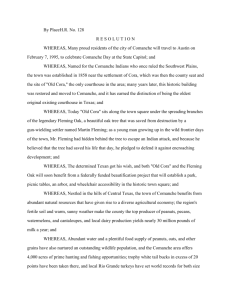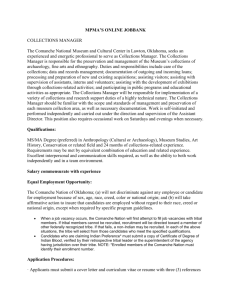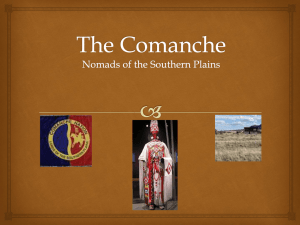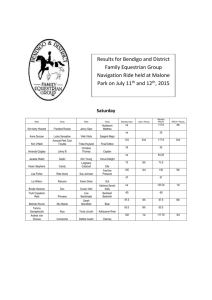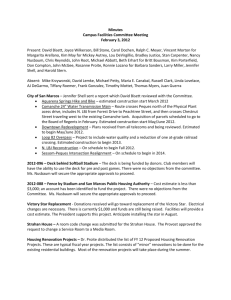Piper Comanche - Tri City Aero Maintenance Inc.
advertisement
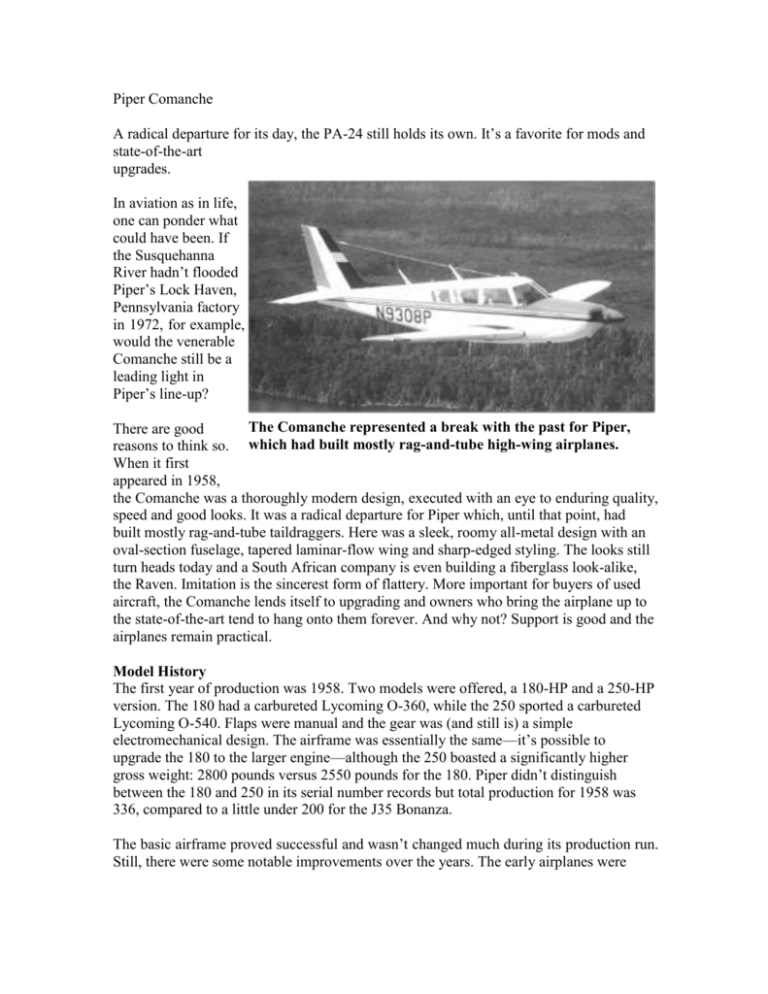
Piper Comanche A radical departure for its day, the PA-24 still holds its own. It’s a favorite for mods and state-of-the-art upgrades. In aviation as in life, one can ponder what could have been. If the Susquehanna River hadn’t flooded Piper’s Lock Haven, Pennsylvania factory in 1972, for example, would the venerable Comanche still be a leading light in Piper’s line-up? The Comanche represented a break with the past for Piper, There are good reasons to think so. which had built mostly rag-and-tube high-wing airplanes. When it first appeared in 1958, the Comanche was a thoroughly modern design, executed with an eye to enduring quality, speed and good looks. It was a radical departure for Piper which, until that point, had built mostly rag-and-tube taildraggers. Here was a sleek, roomy all-metal design with an oval-section fuselage, tapered laminar-flow wing and sharp-edged styling. The looks still turn heads today and a South African company is even building a fiberglass look-alike, the Raven. Imitation is the sincerest form of flattery. More important for buyers of used aircraft, the Comanche lends itself to upgrading and owners who bring the airplane up to the state-of-the-art tend to hang onto them forever. And why not? Support is good and the airplanes remain practical. Model History The first year of production was 1958. Two models were offered, a 180-HP and a 250-HP version. The 180 had a carbureted Lycoming O-360, while the 250 sported a carbureted Lycoming O-540. Flaps were manual and the gear was (and still is) a simple electromechanical design. The airframe was essentially the same—it’s possible to upgrade the 180 to the larger engine—although the 250 boasted a significantly higher gross weight: 2800 pounds versus 2550 pounds for the 180. Piper didn’t distinguish between the 180 and 250 in its serial number records but total production for 1958 was 336, compared to a little under 200 for the J35 Bonanza. The basic airframe proved successful and wasn’t changed much during its production run. Still, there were some notable improvements over the years. The early airplanes were equipped with hand brakes. But after 1960, most Comanches were delivered with optional toe brakes. The original airplane had a 60-gallon fuel system. In 1961, Piper offered an optional 90gallon system, which gave the Comanche 180 seriously long legs: nine hours, provided the load consisted of only the pilot, one passenger and a little luggage. Range remains one of the Comanche’s strong points and many have been fitted with even more fuel capacity in tip tanks and fuselage tanks to give planet crossing ability. In 1961, the gross weight of the 250 was boosted by 100 pounds. Electric flaps replaced the manual ones with the 1962 model year. Production of both the 180 and 250 ended after the 1964 model year. The 180, which obviously came second to its bigger brother in load carrying and which was not selling as well as the 250, was dropped altogether. Evolution The 1965 Comanches are transition airplanes, in that they have the earlier fuselage fit-out mated to the later 260-HP engine, albeit with a carburetor. The big engine gives these airplanes excellent climb performance, as much as 1500 FPM. In 1966, the Comanche B, with a fuel-injected 260-HP Lycoming IO-540, a boosted gross weight (now 3100 pounds) and the installation of two more seats was added. These and later Comanches can be spotted by the extra cabin window and rear baggage door on the left side which doubles as an emergency exit. The airframe dimensions are identical but the fuselage internal structure was changed to accommodate the additional window. The added seats are in the baggage compartment. The Comanche C was rolled out in 1969, with further refinements, including another gross weight increase and a distinctive “shark nose” cowl. The 100-pound rise in gross gave the airplane a hefty 1427-pound useful load. The airplane also gained cowl flaps and an aileron-rudder interconnect. By the time these airplanes were introduced, the production run of the Comanche was about to end without warning, so this variant is comparatively rare. Turbo and 400HP A turbonormalized version of the Comanche C was offered alongside the normally aspirated bird in 1970. Dual turbos allow operation at altitudes up to 25,000 feet. The turbo was a manual Rajay system, which had a “second throttle” wastegate control with which the pilot manually sets boost at altitude. Piper did the turbo 260 installation properly by providing check valves and a turbo oil sump. Upon shutdown, this allows the oil to drain from the hot turbos instead of remaining inside them and cooking. A side benefit of the standard turbo installation is that it’s quieter than the normally aspirated Comanche C. The N1A5 engine, beefed up to handle the boost pressure and higher temperatures at altitude, is just as robust as the normally aspirated engine as the TBO is 2000 hours. Also, as with the fuel injection system, earlier airplanes can have a turbo added. The ultimate in wretched excess, or perfection, depending on your point of view, has to go to the Comanche 400. It was introduced in 1964 and discontinued only a year and 145 airplanes later. This beast had a normally aspirated, fuel-injected, eight-cylinder IO-720 Lycoming fitted with a three-bladed prop. The airframe is essentially identical to the 250, except the 400 uses the Aztec stabilizer. The engine gulps huge amounts of fuel (20 to 22 GPH at 75 percent cruise, held in optional 130-gallon tanks), has a TBO of 1800 hours and costs thirty grand to overhaul. On the other hand, the 400 offers spectacular performance—at least for 1964—with max cruise in the 185 to 195-knot range. When compared to a Comanche B, the 400 has a gross weight 500 pounds higher. However, the empty weight is also higher, by 337 pounds. That extra payload has to go for fuel to feed the IO-720, meaning that for flights of more than 300 miles, the 400 actually has less payload available than the 260. In 1972, there were two single-engine Comanche models still in production—the 260 and turbo 260. Their excellent build quality with total corrosion proofing before assembly and compound curve panels meant that the underlying cost structure was greater than then emerging designs from both Piper and its competitors. Then nature intervened. Tropical Storm Agnes drove the Susquehanna River out of its banks and wiped out the Piper factory in Lock Haven, Pennsylvania. This gave Piper a reason to pull the plug on the airplane, choosing to concentrate on the more popular, less expensive and higher-profit PA-28 line, including the Arrow being produced at the Vero Beach site. Several years ago there was some thought given to resurrecting the design at the hands of the legendary Roy LoPresti, but like the SwiftFury, it came to nothing. LoPresti did create some interesting aerodynamic mods for the airplane, however. Handling Myths abound about the Comanche being difficult to land smoothly because of a tendency to float during the flare, then settle sharply. Some owners dispute this, others confirm it. Comanche experts tell us the attitude window for a smooth arrival is smaller than that of many modern spam cans but no different from some high-performance aircraft or taildraggers. One remedy is to add the Knots2U wing root fillets, which eliminate the vortex striking the stabilator when flaps are used. The International Comanche Society reports that the best way to learn to land—and fly—this bird is to get some dual from an expert in the type, not the local flight school. Fly it like it’s meant to be flown and you’ll wonder what the bar-room chatter was all about. In flight, handling is responsive and pilots report that the Comanche is a sheer delight to fly. As an instrument platform, it’s stable and responsive. At busy airports, it’s no trouble to keep approach speeds right in the flow. With practice and gear down, finals for the ILS can be flown at 130 knots and, gear up, even faster. The aircraft can then be slowed in the last few hundred feet to land short and turn off at the first taxiway. There’s a bit of a tendency to wheelbarrow during crosswind takeoffs, caused by pilots holding the nose down to prevent a premature departure. This, in turn, is due to the airplane’s tail-low stance when sitting on its gear. Some pilots pump up the main gear oleos to reduce the tendency or install a smaller nosewheel tire to reduce the static angle of attack on takeoff. Performance, Loading The Comanche 180 has less-than-stellar speed performance but long legs for its class. Burning 8 to 10 GPH, it will cruise at about 140 knots. An American General Tiger with fixed gear goes just as fast and another contemporary retractable, the Mooney M20C or M20E will outrun the 180. The 180 can climb at 700 to 900 FPM after using more than 2200 feet to clear a 50-foot obstacle. The 250 and 260 are better performers. Speeds are up around 155 to 160 knots at cruise, burning about 12 GPH, Still, these speeds trail contemporary designs of similar vintage and power, such as the Bonanza S-series. As you would expect from aerodynamics 101, the extra 10 GPH the Comanche 400 burns yields only about 10 to 15 extra knots. The 400 will, however, climb like nobody’s business: 1600 FPM. Not many singles can match it. The 180’s load carrying capacity is ample but modest. With a gross weight significantly lower than that of later Comanches, cabin payload with full standard fuel (60 gallons) is about 660 pounds, making it a three-person airplane. The 250 can haul 750 pounds with full standard fuel, while The panels in many older Comanche’s appear dated but the 260s and 400 can lift they don’t have to stay that way. Ray Bengen’s 260B has a up to 1000 pounds. fully upgraded panel with state of the art avionics. The straight roofline that gives the Comanche its distinctive crew-cut looks also reduce visibility upwards, although it’s not as bad as some airplanes and does provide welcome shade in hot climates. The cabin itself is roomy and comfortable with good width if a bit drafty and noisy, say some owners. Legroom is good for both pilots and passengers and the cabin is definitely more spacious than the Arrow that followed. The fifth and sixth seats, when available, are suitable only for children or the smallest of adults. The panel is what one would expect from a circa-1960s airplane, with good space for instruments but early, unrestored models will look dated by modern standards. The panel layout doesn’t conform to the later standard T configuration, so it may be unfamiliar to recently trained pilots. A number of aftermarket panel upgrades are available to modify to the standard T and to incorporate modern avionics and this is a popular modification to a worthy instrument airplane. (Pictures included with this report show some examples.) Maintenance Owners give the maintenance burden mixed reviews. The Comanche is one of the bestbuilt metal singles available and it can be well maintained at lower cost than other lower performers due to the widespread use of generic parts. There’s also a good supply of aftermarket and PMA’d parts for commonly needed items. While the airplane isn’t intrinsically difficult to service, the age of the equipment cannot be ignored. One owner noted that Comanches are old and relatively complex so they shouldn’t be thought of as cheap to maintain. However, with care, costs will be more than manageable. As owners have observed, recurring ADs on Comanches can run up the cost of an annual. One on the landing gear (77-13-21) mandates replacement of landing gear bungees every 500 hours or three years to prevent landing gear collapse after manual extension. There’s also an AD on the vertical fin attachment. The prop inspection AD (95-11-08) is the most oft-complained about, costing over $650 every 500 hours or five years. Also, the new prop AD (97-18-02) can prove costly for 250/260 owners. Many owners have opted to replace their old Hartzells for new two or three blade Hartzell or MacCauley propellers, which solves the AD problem. Apart from the aforementioned ADs, Comanches are unremarkable; most other ADs are minor and/or shotgun directives that apply to many airplanes. The landing gear is not as complex as that of, say, a Cessna 210, but it’s the cause of problems nonetheless. Reviews of service difficulty reports indicate that it’s the numberone trouble spot. The major causes of gear problems are poor maintenance or maintenance by mechanics unfamiliar with the system. Pilots who don’t understand the undercarriage and its various procedures, particularly the emergency extension procedure, are also a source of problems. The International Comanche Society can help on both counts, with a list of qualified instructors and shops familiar with the airplane. Aftermarket gear warning systems are also a good investment to supplement the system originally installed. Mod, Clubs There are so many mods available for the Comanche line that today, probably no two aircraft are alike. You can modify the engine, its look, its handling, its panel and its features. Check a copy of the Comanche Flyer or the ICS Website for details. For instance, it’s possible to retrofit the Lycoming O-540 engine onto a Comanche 180 of 1960 or later vintage; there’s at least one published report of this being done on a Form 337, although we don’t know of any shops that offer the mod. Aside from the engine and prop, it involves the motor mount, some baffling, controls and the exhaust system. The result is essentially a Comanche 250. Also, the carbureted O-540 found in the Comanche 250 may be upgraded to fuel injection. LoPresti Speed Merchants (www.speedmods.com) offers, among other mods, the “Wholey Cowl” originally dreamed up for the Comanche’s resurrection, along with a three-bladed “SynchroPulse” prop. Both are for the 260. Cowlings are also offered by Aviation Performance (www.aviationperformanceproducts.com), which claims that its Eagle XP cowling increases speed, economy and improves maintenance access. The company also offers a stainless steel dual exhaust system. These mods are available for all Comanches except the 400. Knots2U (www.knots2u.com) also offers aerodynamic mods including a wing fillet that one owner reports helps with the airplane’s landing characteristics. Other aerodynamic mods include wingtips from Met-Co-Aire, speed brakes from Precise Flight and Sierra Industries’ R/STOL kit. (Contact www.metcoaire.com; www.preciseflight.com and www.sijet.com.) All are applicable to all Comanches. Other popular modifications include panel upgrades (Ron and Johns or Pfleugers), supplementary gear warnings (Knots2U), new gear wiring harnesses (Comanche Gear), single piece windshields and so on. The list is long and best accessed from involvement with the ICS and its members and publications. Speaking of ICS, owners tell us the group is an exceptionally good resource for Comanche owners. It offers a magazine as well as books and video tapes and be reached at 405-491-0321 or via the Website at www.comancheflyer.com. ICS also offers a technical support service when you and your mechanic need someone to talk to. There are two Comanche forums on the net. One is the official ICS site and the other is at www.dephiforums.com. (Search Comanche.) Reader Feedback After flying into a 40-knot headwind westbound from Virginia in my Piper Arrow, watching the traffic on the interstate moving faster than my plane, I decided to look for a faster single-engine airplane. I had previously flown in a single Comanche and a twin Comanche and liked both planes. Without a twin rating I did not want to consider two engines. The single Comanche seemed to be a good purchase at the time. The choice was between a fully restored airplane and a fixer upper. My wife and I selected the latter. In August 1997, we purchased N8582P, a 1965 PA-24-260. The initial price was $44,000. Our first work on the plane was done at J. A. Air Center at DuPage Airport. We redid the panel, adding a Bendix/King KLN89B, Strike Finder, S-Tec System 30 autopilot, NAT intercom, Shadin fuel flow indicator, JPI EDM monitoring system and we converted one KNX 170B to a MAC 1700. Cameron Interiors on the field installed a new leather interior. Our first annual in July 1998 was an expensive one, $8700. We did the AD 77-13-21 which involved inspection of gear component bushings and bolts, cleaned the flap tracks and installed new nylon rollers, replaced the brake pads, replaced the Lord mounts, installed a missing fuel strainer access panel and fuselage doublers plate in fuselage belly. We have added several speed mods including flap and aileron gap seals, a Knots 2U wing fillet, wing root faring, windshield Cowler and gear lobe fairings. In May 2002 we had our airplane painted at Dial Eastern States Aircraft Painting at Cadiz, Ohio. We had the good fortune of meeting Craig Barnett of Scheme Designers at Sun ‘N’ Fun just a few weeks before we had the painting done. His design turned out very well and we have received several awards at Oshkosh and at the International Comanche Society (ICS). Flying the Comanche is a dream. The airplane is very stable in IFR conditions. We routinely flight plan for 155 knots but will see 160 to 162 knots at lower altitudes. We generally fly at 10,000 to 14,000 feet which gives us 55 to 60 percent power. Our endurance, however, is great these altitudes. Even without tip tanks, we can count on five to six hours at 155 to 158 knots. Comfort is good. The cabin is wide enough for my son If you want to go fast, climb like hell and and I, both of us being over 200 pounds, you’ve got the money to pay for the gas, the to sit shoulder to shoulder without IO-720-powered Comanche 400 is just the feeling cramped. thing. Costs are what you would expect for a high-performance retractable. Insurance is a big factor with ever increasing cost for less coverage. We paid $3300 for our last premium with a 1000-hour and a 500-hour pilot, both instrument rated. Annuals run between $2500 and $3500 depending on what we add extra. Parts have not been a real problem. There are several good resources. I can recommend Webco in Newton, Kansas. Altus Aircraft Services (www.altusaircraft.com) in Oklahoma has been a valuable contributor to the ICS. I strongly encourage anyone thinking about a Comanche to check with the ICS. This is an older airplane and needs some special consideration. -Bill and Susan Harryman Marion, Illinois I purchased my 1958 PA24-250 Comanche, N71HK, in July of 1978, so I have owned it for just 26 years now. When I purchased this Comanche, it had the Johnson Bar brakes. I lusted for toe brakes until 1989, when I had new rudder pedals/toe brakes installed on both sides. That is a fine modification to the aircraft. I typically fly around 3500 feet to 4500 feet with a manifold pressure of 21 inches and 2300 RPM. I lean to 11.5 to 12 gallons per hour. This gives an indicated airspeed of 160 MPH. A look at my records shows an oil consumption rate of a quart about every seven hours. I have a private pilot license with 760 hours total time, 646 hours retractable time and 588 in the Comanche. The Comanche has been typically insured for a hull value of $48,000. Premiums have run in the $1400 range. After having the new instrument panel installed, I increased the hull value to $54,000 and my insurance premium increased to $1903. Annual inspections typically run $1,200 to $1,500, depending on what things I might add, such as the EDM EGT/CHT/fuel flow instrument. The engine now has 2745 hours total time and 1855 hours since major overhaul. As a tip to anyone who would like to try it, I flew the Comanche trimmed for an approach speed of 80 MPH, gear and flaps down. With the airplane trimmed like this, I put a mark next to the trim setting bug. Now, if my landing approach is looking normal as I come down final (which is the typical scenario), I will set the trim bug next to this mark. With 18 degrees of flaps the Comanche carries a nice speed, about 90 MPH, down final. When I add full flaps (27 degrees), she slows to 80 MPH and the rest is up to me. My Comanche has been hangared since I bought it. I’m sure this has helped immensely in keeping it looking nice. The Comanche had apparently been painted not too long before I bought it. It still looks pretty good. I was looking for a Mooney when I saw the Comanche for sale. A review of the numbers on a Mooney I could afford in 1978 revealed that the Comanche could carry four people, baggage and full fuel. The Mooney could not. And, of course, the Comanche has more room for the persons on board as well as a larger instrument panel. I have flown with four people, full fuel and baggage, non-stop from Dallas Redbird airport to New Orleans Lakefront airport. We cruised at 9500 feet. This is about a 450statute mile trip and took 2.75 hours. Fortunately, my airplane is so old; most of the ADs don’t apply. I will periodically have to deal with the recurrent prop AD and have chosen to do that rather than going to the three-blade prop that seems to have problems of its own. The International Comanche Society is a great organization. It has an excellent monthly magazine plus many publications to aid in aircraft maintenance and flying. Updated owner’s manuals are available for all models, so there is a lot of good information available for operating the Comanche. Parts have not been a problem for my Comanche, but I have not needed many, either. -Vittorio K. Argento Cape Coral, Florida I am an ATP and A&P/IA in Southern California and I like working on Comanches, both singles and twins. They are a well-built, strong aircraft that is as straightforward as you can get with a high-performance aircraft and certainly better built than the recent offerings. The Comanche has a reputation for having a lot of airworthiness directives and while the list is long, most of them are for non-repetitive items and the routine ones are relating to gear inspections and internal wing, flap and stabilator inspections. Usually, if an airplane has been cared for, there are few problems. Parts are available, so that aspect is not a problem and with LoPresti and Knots2U and the excellent support of Webco, I find the Comanche is not difficult to maintain. The flying characteristics are excellent; stable with good speeds and strong, which, in heavy weather, is comforting. I’ve noted. for example, that the Saratoga is a 3600-pound aircraft. The single Comanches are a little less than that. The Saratoga has a single wingspar which is wrapped at the base for extra strength and the Comanche has a tough main spar, a minor spar and a stiffener across the rear of the wing. While I’ve never seen one, I’ve heard lore about Comanches becoming inverted in thunderstorms and actually bending at the fuselage but the wings staying intact and the occupants flying out of the storm to tell the tale. I rarely see any corrosion in Comanches. While I am in Southern California and we don’t often see corrosion out here, even the airplanes from the east coast are clean. There is a recommendation that the stabilator be removed occasionally to find any corrosion r from paint stripper getting into the support tube in the stabilator. I’ve done this inspection and I’ve never seen any corrosion in the tube. The weakest link in the Comanche is the wiring out to the squat switch and landing gear contact switches. This is configured so that the wiring bends into an S every time the gear is raised. This is a Piper design flaw rather than a Comanche flaw and there is a gentleman named Matt Kurke who builds replacement wiring that routes the wiring differently and stops the bending of the wires. The Comanche is a solid, durable airframe that’s stable and outperforms other competitive aircraft with comfort, endurance and quiet. The Cessna 210 is not as well built. The Mooney is faster, but noisier and less roomy. The Beechcraft is almost the same cabin dimension but a higher price. The affordability and reliability of the Comanche keeps appealing to buyers. It can be modified to for greater speed and endurance and with panel upgrades equal to or better than any competitor. I couldn’t compare them to the Cirrus or the Diamond, yet when a Comanche is damaged it takes sheet metal repair in the field to repair it. The Cirrus and the Diamond have to go to a specialist due to their composite construction. -Patric Barry Barry Aviation Laguna Hills, California


